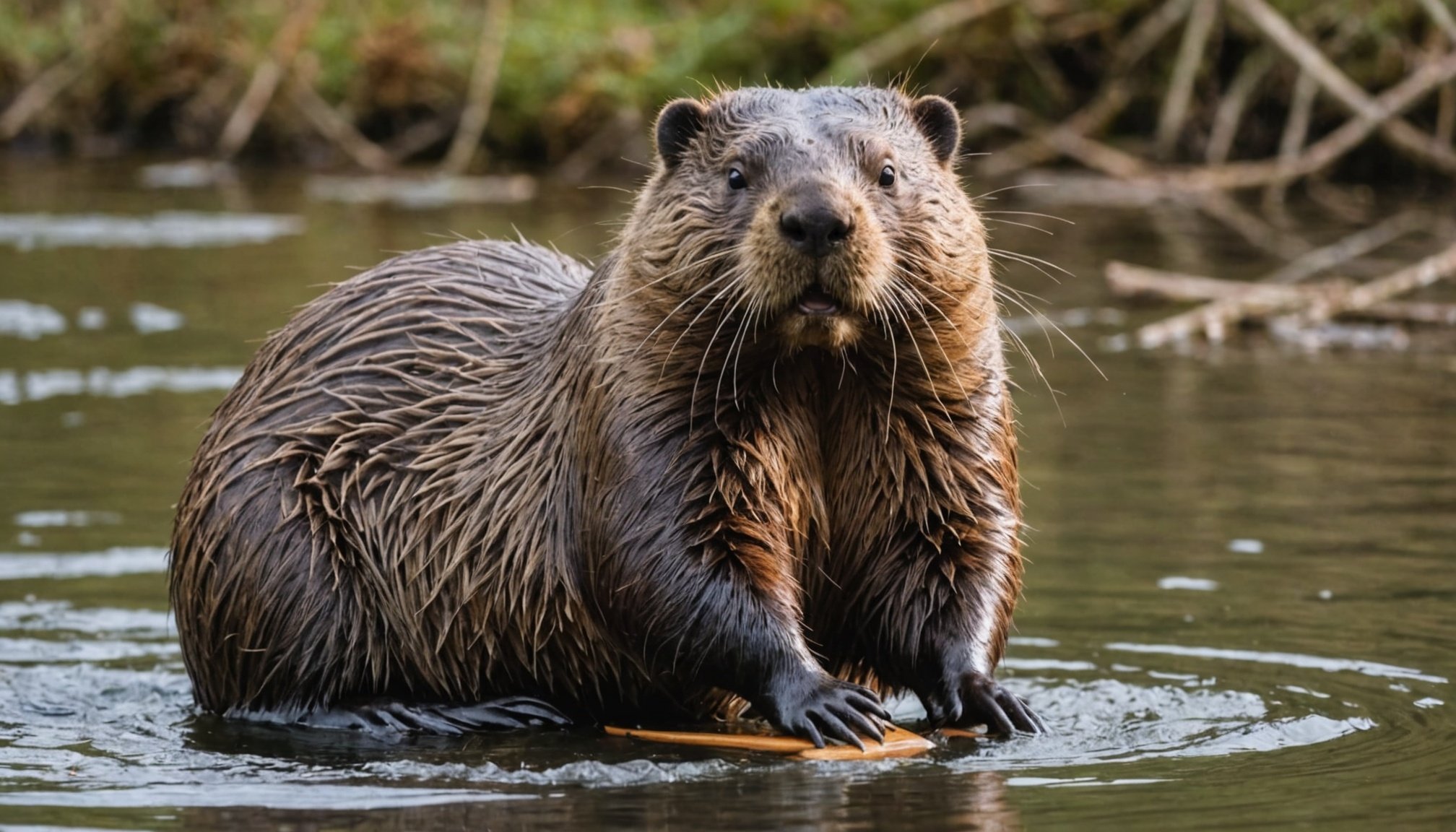Navigating Beaver-Human Conflicts: Innovative Strategies by UK Conservationists
Understanding the Beaver Species
Beavers, particularly the Eurasian beaver (Castor fiber), have been a subject of both fascination and conflict in the UK. These large rodents, known for their remarkable engineering skills, have been reintroduced to various parts of Britain after being nearly extinct in the early 20th century. Here’s a closer look at why beavers are so significant and the challenges they pose.
Beavers are ecosystem engineers, renowned for their ability to construct complex dams, lodges, and canals. These structures not only provide them with a safe habitat but also create wetland ecosystems that benefit numerous other species, including fish, waterfowl, and plants.
Dans le meme genre : Transform Your Garden into a Dormouse Sanctuary: A Guide for UK Residents to Support Endangered Species
The Impact of Beaver Activity
The reintroduction of beavers has had several positive impacts on the environment, but it has also raised concerns among landowners and farmers.
Positive Impacts
- Water Quality Improvement: Beaver dams can improve water quality by trapping sediments and pollutants, creating cleaner water downstream.
- Habitat Creation: The wetlands formed by beaver dams provide habitat for a variety of wildlife, increasing biodiversity.
- Flood Control: Beaver dams can help regulate water flow, reducing the risk of flooding downstream.
Negative Impacts
- Agricultural Damage: Beaver activity can lead to the flooding of agricultural lands and the destruction of crops.
- Infrastructure Damage: Dams can cause roads and fields to flood, leading to significant economic losses for landowners.
Managing Beaver-Human Conflicts
To mitigate these conflicts, UK conservationists have developed several innovative strategies.
A lire en complément : Designing Urban Green Spaces in the UK: A Blueprint for Supporting Amphibian Habitats
Stakeholder Engagement
Engaging with various stakeholders, including landowners, farmers, and local communities, is crucial. For instance, NatureScot’s Peatland ACTION programme involves targeted engagement with landowners to understand their concerns and educate them about the benefits of peatland restoration, which can also apply to beaver management.
Beaver Management Plans
Conservationists like Campbell Palmer and the Beaver Trust advocate for managed beaver reintroduction. This involves:
- Monitoring Beaver Activity: Regular monitoring to assess the impacts of beaver activity and identify areas where conflicts may arise.
- Dam Management: Selectively removing or modifying dams to mitigate negative impacts while preserving the ecological benefits.
Education and Awareness
Changing attitudes towards beavers is key. Educational programs can help the public understand the ecological role of beavers and the benefits they bring. For example, the Devon Beaver Trial, led by the Devon Wildlife Trust, has shown that educating local communities about beaver benefits can significantly improve public attitudes towards these animals.
Case Studies: Successful Beaver Management in the UK
Devon Beaver Trial
The Devon Beaver Trial is a landmark project that has demonstrated the effectiveness of managed beaver reintroduction. Since its inception, the trial has shown a significant increase in biodiversity and improved water quality. The project involves close collaboration with local landowners and farmers to address any concerns and implement mitigation measures.
East Kent Beaver Project
In East Kent, a similar approach has been adopted. The East Kent Beaver Project focuses on reintroducing beavers in a controlled manner, with ongoing monitoring and community engagement. This project has highlighted the importance of human dimensions in wildlife management, ensuring that local communities are involved in decision-making processes.
Human Dimensions in Beaver Management
Understanding the human dimensions of wildlife management is critical for successful beaver reintroduction.
Social Science Research
Projects like those proposed by NatureScot emphasize the need for social science research to understand public attitudes and perceptions towards beaver restoration. This includes identifying misconceptions and barriers to support, which can be addressed through targeted communication and education strategies.
Community Involvement
Involving local communities in the decision-making process can foster a sense of ownership and responsibility. For instance, the Gaywood Valley project in Norfolk has seen local residents actively participating in beaver management, helping to monitor beaver activity and maintain dams in a way that balances ecological benefits with human needs.
Practical Insights and Actionable Advice
For those interested in beaver conservation or managing beaver-human conflicts, here are some practical insights:
Building Support
- Educate and Engage: Educate local communities about the benefits of beavers and involve them in the decision-making process.
- Collaborate with Landowners: Work closely with landowners to address concerns and implement mitigation measures.
Monitoring and Management
- Regular Monitoring: Monitor beaver activity regularly to assess impacts and identify potential conflicts.
- Selective Dam Management: Manage dams selectively to balance ecological benefits with human needs.
Community-Led Initiatives
- Community Projects: Support community-led projects that involve local residents in beaver management and conservation efforts.
Navigating beaver-human conflicts in the UK requires a multifaceted approach that includes education, stakeholder engagement, and innovative management strategies. By understanding the ecological role of beavers and addressing the concerns of local communities, conservationists can ensure that these ecosystem engineers continue to thrive while minimizing conflicts.
As Consorte McCrea, a leading figure in beaver conservation, notes, “Beavers are not just animals; they are ecosystem engineers that can transform landscapes. By working together with local communities and landowners, we can ensure that their reintroduction benefits both wildlife and people.”
Table: Comparing Beaver Management Strategies
| Strategy | Description | Benefits | Challenges |
|---|---|---|---|
| Stakeholder Engagement | Engaging with landowners, farmers, and local communities to understand concerns and educate about benefits. | Builds support, addresses concerns early. | Requires ongoing communication and trust-building. |
| Beaver Management Plans | Monitoring and selectively managing beaver dams to balance ecological and human needs. | Reduces conflicts, preserves ecological benefits. | Requires resources for monitoring and management. |
| Education and Awareness | Educating the public about the ecological role of beavers. | Changes attitudes, increases support. | Can be time-consuming and resource-intensive. |
| Community-Led Initiatives | Involving local communities in beaver management and conservation. | Fosters ownership and responsibility. | Requires community buy-in and ongoing participation. |
Detailed Bullet Point List: Steps for Effective Beaver Management
- Conduct Initial Assessments:
- Evaluate the suitability of the area for beaver reintroduction.
- Assess potential impacts on local ecosystems and human activities.
- Develop Management Plans:
- Create plans that outline monitoring, dam management, and conflict mitigation strategies.
- Involve local stakeholders in the planning process.
- Implement Monitoring:
- Regularly monitor beaver activity and its impacts.
- Use data to adjust management strategies as needed.
- Engage with Local Communities:
- Educate local residents about the benefits and potential impacts of beavers.
- Involve communities in decision-making and management processes.
- Manage Dams Selectively:
- Remove or modify dams that cause significant conflicts.
- Preserve dams that provide ecological benefits without causing harm.
- Address Conflicts Proactively:
- Work with landowners to mitigate agricultural and infrastructure damage.
- Implement measures to protect crops and infrastructure from flooding.
- Review and Adjust:
- Periodically review the effectiveness of management strategies.
- Make adjustments based on new data and community feedback.
By adopting these strategies, UK conservationists can navigate the complexities of beaver-human conflicts, ensuring that these remarkable animals continue to thrive while minimizing their impact on human activities.











